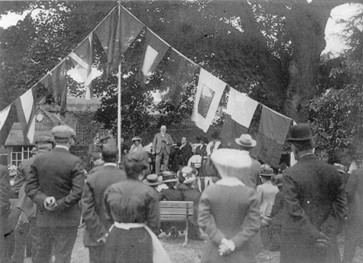The official opening was by Waynman Dixon, whose rather curious inaugural speech was almost entirely devoted to the vexed issue of whether such a club should sell intoxicating liquors. Great Ayton had a strong temperance movement, and Waynman Dixon himself had been brought up as a Quaker. However, the Club was established on a broad-minded basis and the sale of alcoholic drinks was approved on the basis that “we do not believe that prohibition or restriction can ever achieve in any man the power to resist temptation, but we think that the influence of the Club should help keep young men from frequenting public house bars where there is no such good influence about.”

There is little doubt that social activities took precedence over political activities. A wide range of newspapers and magazines was available to members, from Throne and Country to Tit Bits. For the first two years football results were wired to the club; the BBC didn’t start broadcasting until 1922.
A piano was purchased in 1912. In 1929 there were arguments before it was agreed to install a fruit machine (referred to as a “fun machine”). The same year, electric lighting and mains water was installed in the Club. Almost unbelievably, a urinal was not installed until after the Second World War. Club members had to walk to the bottom of the yard to relieve themselves. Perhaps Waynman Dixon regretted his opposition to the siting of a public urinal by the Stone Bridge, only seven years before he opened the Club in 1910.
Billiards was one of the most popular activities in the Club. A billiards room was part of the Club, and straight away there was pressure for a second table. Space was to be a problem, and the purchase of an ex-Army hut to accommodate a second table was considered in 1946, but no suitable hut could be found. Snooker was introduced in 1923, and gradually took over from billiards, although there were complaints about “the selfishness of members playing Snooker to the exclusion of Billiards”. Cards and dominoes have always been popular, although Brag and Pontoon were banned.

This is not to imply that the Club was not involved in politics. From 1922 subscriptions, initially one guinea, were paid to the Richmond Conservative Association. At the time of General Elections, the premises were used as Committee Rooms. In 1944 a portrait of Winston Churchill was purchased, which still hangs in the Club. In 1945, the year that the post-war Labour Government was elected, there were complaints that some members were making statements against the Conservative Party. Members were reminded that, although “everyone is entitled to his own political views” every new member had affirmed that he was “a Conservativet and a supporter of the conservative party.”
An interesting comment on the Club’s place in the national hierarchy occurred in 1944 when the Club’s iron railings, along with many others in the village, were taken down to add to Lord Beaverbrook’s national drive for scrap iron. The railings at Cleveland Lodge, home of Sir John Fry, were left intact.
Financial irregularities troubled the Club in the 1924. The steward could not account for deficits in the accounts. Reasons given were “treating friends at the Club’s expense” and his claims of “wastage in every cask of beer sold”. On the third such occasion he was instantly dismissed.
From the start, the Club premises were leased from the Donaldson family, who owned the farm next door. On the look-out for their own premises, an attempt was made in 1943 to purchase Cliff Rigg and the adjoining cottage on Newton Road, the house originally built by the first superintendent of the Friends’ School, George Dixon, for his retirement. The Club’s offer of £1,600 was not accepted, and then attempts were made to purchase a building plot. A plot on Linden Avenue was identified, but nothing came of this. An offer to purchase the premises from Mr Donaldson was made in 1959, but turned down. At last, in 1971, the premises were purchased by the club for £10,000.

Apart from its social and political
functions, the Club has made numerous donations to charities and has supported village events. The first collection, in 1913, was for the relief fund set up after a Welsh coalmine disaster claimed 439 lives. More recent donations have been to Cleveland Search and Rescue and Children in Need.
Reference
The first 100 years, 1910-2010 Ernie Taylor
Great Ayton Conservative Club
Fill in the form below